
Abstract
Assimilation and contrast have opposite effects: Contrast leads to an increase of perceived differences between neighbouring fields, whereas assimilation leads to a reduction. It is relatively easy to demonstrate these effects, but the precise localisation of these effects in the perceptual system is not yet possible. In an experiment the strength of assimilation effects was modified by adding spatial noise. By varying the localisation in perceived space of the added noise (by presentation of the noise pattern with different binocular disparities) the masking effect of this noise can be influenced. Masking caused by binocularly disparate noise is less than masking caused by binocularly non-disparate noise. Our conclusion is that the effect at least partly occurs beyond the (binocular) locus of separation in different depth planes. A similar approach, involving moving noise, will also be presented. Finally, several demonstrations show that images that are peripherally similar can give rise to differences in the perceived amount of assimilation. These effects further indicate that a central mechanism is involved in assimilation.
Assimilation is a perceived change in colour and/or brightness in one part of a picture in the direction of the colour and/or brightness of another part or other parts in the picture. The simplest case is a change in perceived colour of the background in the direction of the colour parts belonging to the foreground. Assimilation is more common in daily visual scenes than the better known simultaneous contrast effect DeValois and DeValois, 1988). Since the discovery of receptive fields with a center-surround structure, lateral inhibition has been the most popular tool for explaining basic visual processes. Undoubtedly it is an important mechanism. The shape of the luminance contrast modulation transfer function can easily be understood on the basis of the mechanism of lateral inhibition, which in turn, finds its physiological basis in spatial opponency of the center-surround receptive fields.
Assimilation has been known for a long time (Von Bezold, 1874; Helson, 1963). Kanizsa (1979) described a particular aspect of the assimilation effect, namely the influence of the observerís attitude. Assimilation effects are most distinct if the observer does not fixate steadily. In fact, he stated that an untrained observer clearly perceives assimilation, whereas a trained observer like a painter, is less certain whether contrast or assimilation occurs (Kanizsa was both a painter and a scolar of visual perception. Kanisza ascribed this difference to the distinction that trained observers make between the chromatic characteristics of objects and the nature of the illumination, and he supposed that the untrained observer completely ignores this distinction.
Festinger, Coren and Rivers (1970) explained the occurrence of contrast or assimilation in terms of foreground / background perception: if part of a stimulus is considered foreground, contrast occurs between this part and the background, but if the same part of the stimulus is seen as background assimilation occurs within this part. This implies that the occurrence of assimilation does not precede figure-ground separation, or at least is dependent upon this separation to some extent. In the extreme case this means that assimilation only occurs after figure-ground separation, which is unlikely to be a retinal phenomenon. Another explanation is that the process of assimilation (and possibly also of contrast) is in principle a peripheral effect, but with strong feedback from a central level (Gove, Grossberg and Mingolla, 1995). Indications for central effects pertaining to contrast phenomena have also been provided by DeValois and DeValois (1988). Sugita (1978) provides evidence that assimilation has a cortical origin, but no such evidence for contrast.
The neon spreading effect described by Cicerone, Hoffmann, Gowdy and Kim (1995) also seems to point to the idea that figure-ground analysis (or more probably in our view a splitting of material and illumination properties) must have occurred before assimilation takes place, but not the reverse. In their case, the neon spreading effect (van Tuijl, 1975, van Tuijl and de Weert, 1979) occurs over a number of red dots in a surround of green dots, when the red of the dots moves as a spotlight over the dots, replacing the green colour of the dots in the background.
The notion of complex interactions occurring in the
perception of illumination, material properties and chromatic properties
is strongly supported by Adelson (1993). It is rather unlikely that changes
in appearance as demonstrated in Adelsonís examples can be explained at
a peripheral level.
In this paper we study possible central processing
aspects of the assimilation effect. First we describe the results of one
simple experiment, subsequently we demonstrate a number of effects unlikely
to have an exclusive peripheral basis.
The idea of the experiment and the demonstrations derive from a central theme: In some way the occurrence of assimilation and/or contrast is connected to the mechanism of attention, which is involved in the process of separating figure from ground. This separation is a central task for the visual system and it is a complicated process because it can also entail separation of material and illumination properties.
The stimulus used in the experiment has been employed in many demonstrations and experiments (de Weert and van Kruysbergen, 1987; de Weert,1991; de Weert and Spillmann, 1995), and proved to cause strong assimilation effects

Figure 1. The stimulus used in the experiment. Figure 1a shows the basic stimulus. The pincushions within the black borders look darker than the pincushions within the white borders, even though the luminances of the pincushions are the same. Figure 1b shows the same stimulus with lower contrast and with noise added.
Figure 1a shows pincushion-like areas with identical levels of luminances. The area bounded by dark lines looks considerably darker than the area bounded by white lines.
By adding noise to the entire stimulus, we expect a reduced assimilation effect (see Figure 1b). Suppose that this is the case (as will be tested in the experiment), than the following hypothesis can be put forward: If noise is perceptually separated from the stimulus prior to the level at which the assimilation effect originates, then the strength of the original effect should be regained.
Two methods can be used to present stimuli such that noise can be perceptually separated from the original stimulus. The first method is to separate noise by adding identical noise patterns to the monocular test stimuli with some disparity. Binocular fusion of the two pictures can, with the proper disparity, result in a perceptual separation of the noise from the stimulus. Imagine that noise is added such that the noise appears in stereoscopic view as a layer in front of the assimilation stimulus. The question then is whether this perceptual separation gives rise to the perception of an assimilation pattern in the stimulus that is similar in strength to that of the undisturbed original stimulus.
The second method is to separate the noise patterns perceptually from the original stimulus by superimposing moving noise onto the stimulus. It is also possible to present the moving noise in another depth plane, in which case we expect the assimilation effect of the stimulus to be less disturbed than in the case where there is also disparity, but with a static noise pattern.
Stimuli
The stimulus shown in Figure 1a is the basis of the stimuli used in this experiment. Three different levels of contrast were used. The luminance of the dark screen was 0.03 cd/m2, the luminance of the pincushions was 8.5 cd/m2, the luminances of the lines for the high contrast stimulus were 14.8 and 3.1 cd/m2, for the medium contrast stimulus 13.6 and 3.5 cd/m2, and for the low contrast stimulus 12.4 and 4.1 cd/m2. The stimuli could contain random noise, as shown in Figure 1b. The luminance of the noise was equal to the luminance of the dark screen.
The added noise was either static or dynamic (moving to the right). The noise could occur in one of three depth planes, including the same plane as the stimulus. This led to 21 possible stimuli.
An example of a trial is presented in Figure 2. For convenience of the reader both crossed and uncrossed viewing are supported, but in our experiment only the left and center figures were presented. The left stimuli were presented to the left eye and the others to the right eye by using a septum. Thus, subjects always saw the stimuli dichoptically. The stimuli were presented on a Philips 15B monitor, run by an Atari TT030 in greyscale-mode, in a darkened room. The visual angle of the stimulus was 10.9 * 7.4 degrees. The disparity of level zero was 0 degrees (noise in the same plane as the stimulus), the disparity of level one was 0.6 degrees and the disparity of level two was 1.2 degrees. The size of the noise dots was 8*8 pixels (0.27 degrees). The amount of noise added was 30 per cent: For each position a random integer between 0 and 9 was drawn: If it was below 3 the stimulus was replaced by a black square, otherwise the original stimulus was shown on that spot. If the noise was moving it moved with a velocity of 8.7 degrees/second.
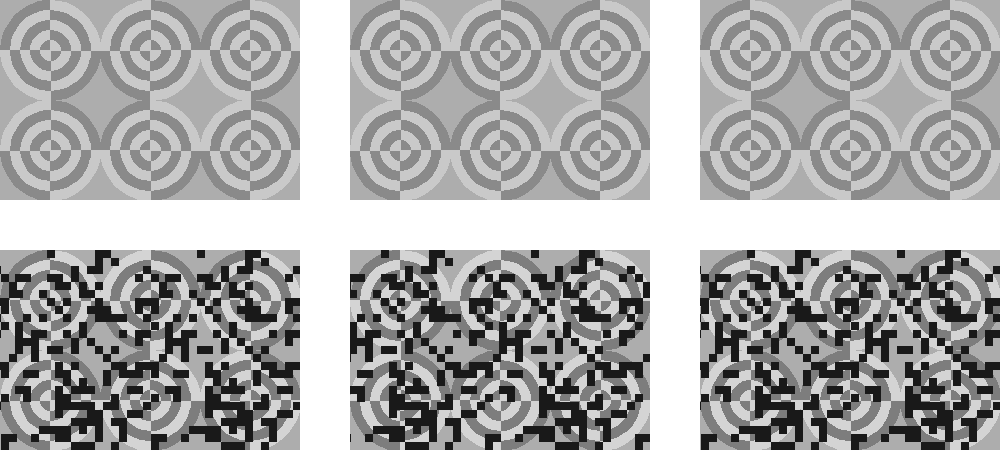
Figure 2. At the top a stimulus of middle contrast, at the bottom a stimulus of high contrast, with noise at depth plane 1. The left and middle figures are for uncrossed viewing, the middle and right figures are for crossed viewing.
Subjects
Three subjects participated in this experiment: the two authors and a third subject, not involved in assimilation research.
Method
Subjects saw two stimuli, one at the top and one at the bottom of the screen. The task was to decide in which stimulus the brightness difference between the central pincushion on the left side and the central pincushion on the right side of the stimulus was larger. In case the effect appeared stronger in the top stimulus they had to press the Up-arrow key and if the effect appeared stronger in the bottom stimulus they had to press the Down-arrow key.
All 21 possible stimuli were presented pairwise, resulting in 21*20/2=210 trials in one session. These trials were randomized. Each subject took part in five sessions. The summed number of times that a particular stimulus gave rise to a stronger assimilation effect than any of the other stimulus types led to a rank order of the stimuli for that particular subject.
Results
Table 1 shows the resulting rank order of the stimuli. Kendall's coefficient of concordance (W=0.9479) leads to a Chi-square of 56.87 (df=20), which is highly significant (p<0.001), indicating that the rank orders of the subjects are statistically the same.
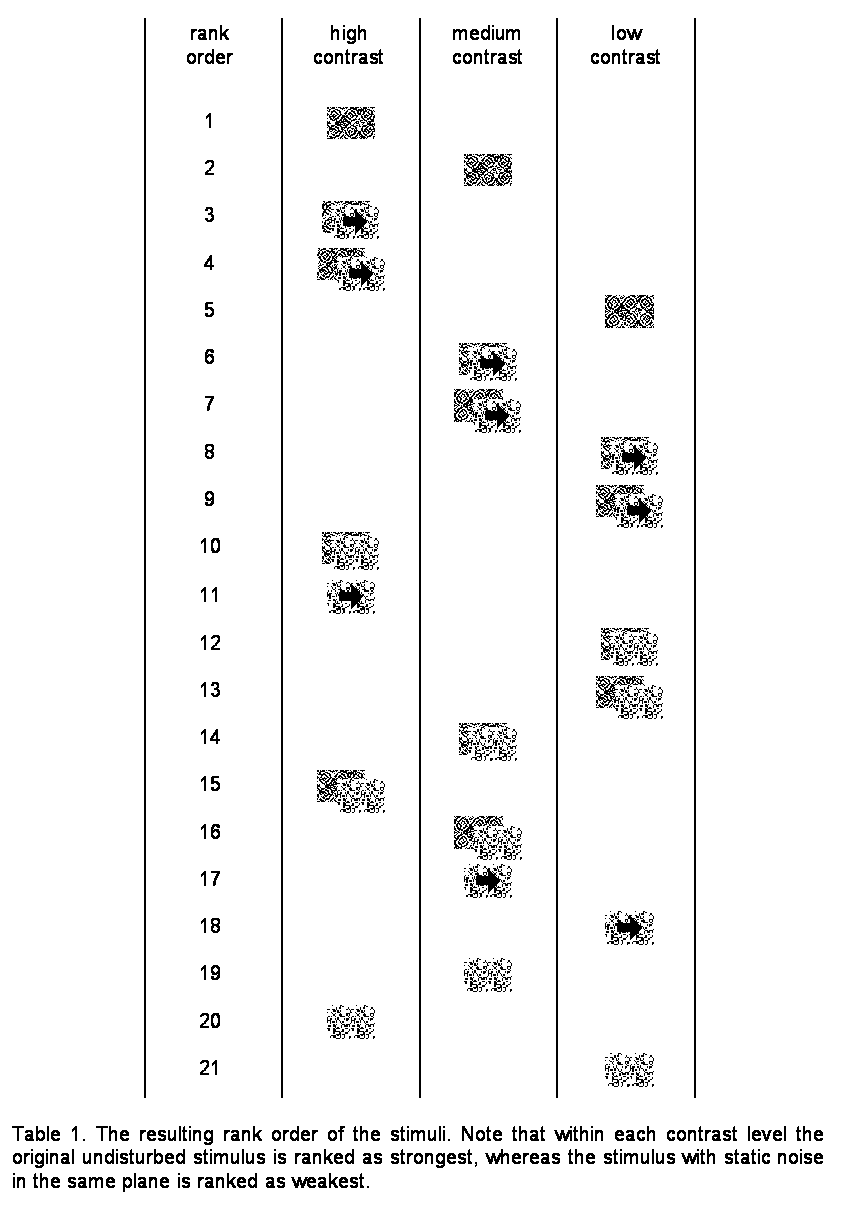
As expected, within each contrast level the strongest effect is perceived in the undisturbed stimulus, whereas the weakest effect is obtained for the stimulus with stationary noise in the same depth plane. In between these two, the rank order roughly corresponds to the 'amount of evidence' for separation of figure and noise layer, either by depth or by motion or by both. Clearly, the effect of depth and motion together yields the strongest recovery of the original, undisturbed effect. For all three contrast levels, the original, undisturbed stimulus is the strongest, followed by the stimuli with the moving noise appearing in another depth plane. If stationary noise is used in another depth plane the perceived assimilation effect is larger than in the case when the noise is shown in the same depth plane, but it is smaller than in the case the noise is moving. If moving noise is presented in the same depth plane there is still recovery. Only one violation of this general order occurs in the rank order of the high contrast stimuli. In that case the moving noise in the same depth plane leads to a larger assimilation effect than stationary noise in a depth plane with the largest disparity.
Note that for the rank order of each individual contrast level separation of noise and figure by a small disparity leads to a stonger effect than when the noise and the figure are separated by a large disparity. Whether that is truly the case cannot be derived statistically from our data.
Discussion
The results clearly support the idea that separation of figure and noise leads to a recovery of the strength of the assimilation effect.
The second part of this paper has the character of a set of demonstrations rather than of a real experiment. The main aim is again trying to separate parts of a figure, either through stereo or through other methods and to test whether separation of figure and ground leads to an observable change in assimilation.
In Figure 3 the red and the green dots are seen in different depth planes. In the upper part the red dots are perceived in the background plane, in the lower part the green dots are perceived in the background (or the reverse depending upon the disparity). All five subjects clearly and systematically saw the colours of the background as different in the two cases: In the upper case the plane in the background was perceived greenish, and in the lower case the background plane was perceived as more reddish than the surrounding. Apparently, the observed assimilation corresponds to the assimilation occurring in the background plane.
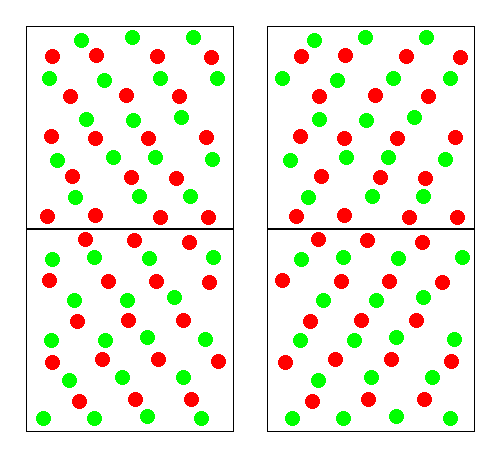
An interesting stimulus producing a change in appearance within a single plane is presented in Fig 4. Here the 'redí plane and the 'green' plane cross in depth along the vertical midline, and with this crossing the appearance of the background changes.
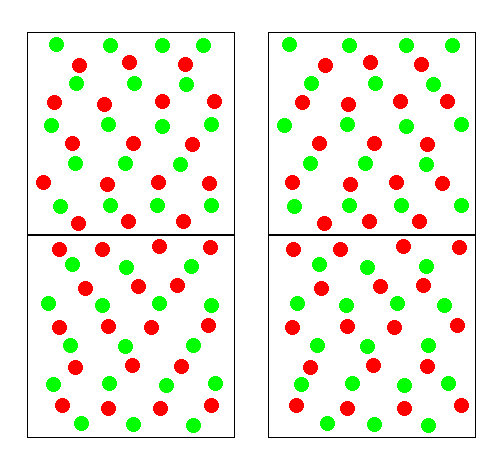
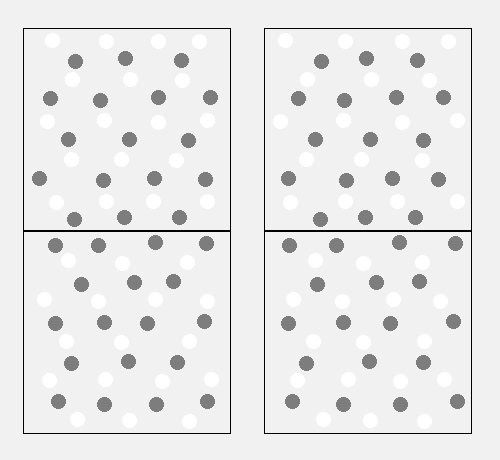
Figure 4. This figure, when viewed stereoscopically, gives rise to two planes crossing in depth at the vertical midline.
A similar effect may be observed in Figure 5. With careful inspection of one of the monocular stimuli, a similar splitting of the depth planes and even a reversal can be seen. Again, subjects observed a change in appearance of the perceived background figure if the percept of the red-lined figure (ìbackground looks reddishî) alternated with the percept of the green-lined figure (ìbackground looks greenishî). Or in case of the achromatic stimulus: If the percept of the white-lined figure (ìbackground looks brighterî) alternated with the percept of the black-lined figure (ìbackground looks darkerî).
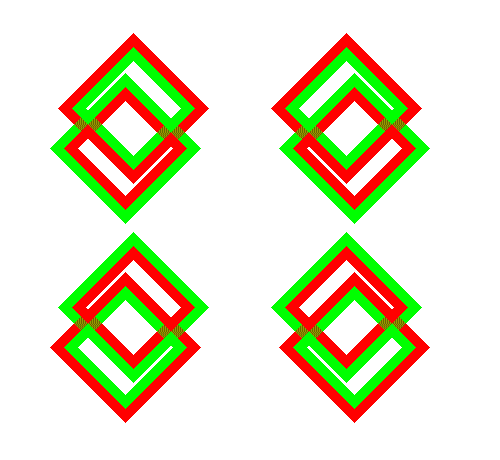

Figure 5: Stereoscopic combination leads to
the perception of two figures in depth and to different patterns of assimilation.
We conclude that assimilation cannot simply be a local retinal effect. In previous papers (de Weert, 1991; de Weert and van Kruysbergen, 1987) it was argued that assimilation effects were based on local averaging of colour and/or luminance within large receptive fields. This cannot be maintained any longer, as the experiments clearly show that assimilation occurs after separation of the picture into figure and ground or at least after separation into different depth planes.
The demonstrations illustrated in this study imply that whatever the precise nature of the assimilation process, it cannot be a pure bottom-up retinal process.
References
Adelson E. (1993) Perceptual Organization and the judgment of brightness. Science, 262, 2042-2044.
Cicerone C., Hoffman D., Gowdy P.D., and Kim J.S. (1995) The perception of color from motion. Perception & Psychophysics, 57, 761-777.
DeValois R.L. and DeValois K. (1988) Spatial Vision. New York: Oxford University Press.
De Weert Ch.M.M. and van Kruysbergen A.W.H. (1987) Strength of subjective contours and perceived superimposition: transparency as a special case. In S.Petry and G.meyer (Eds.): Perception of Illusory Contours (pp 165- 170). New York: Springer.
De Weert Ch.M.M. (1991) Assimilation versus contrast. In A.Valberg and B.B.Lee (Eds.): From Pigments to Perception (pp 305-311). New York: Plenum.
De Weert Ch.M.M. and Spillmann L. (1995) Assimilation: asymmetry between brightness and darkness. Vision Research, 35, 1413-1420.
Festinger L., Coren S. and Rivers G. (1970) The effect of attention on brightness contrast and assimilation. American Journal of Psychology, 83,189-207.
Gove A., Grossberg S. and Mingolla E. (1995) Brightness perception, illusory contours, and corticogeniculate feedback. Visual Neuroscience, 12, 1027- 1052.
Helson, H. (1963) Studies of anomalous contrast ands assimilation. Journal of the Optical Society of America, 53,179-184.
Kanizsa, G. (1979) Organization in Vision.:Essays on Gestalt Perception. New York: Praeger Special studies.
Sugita, Y. (1995) Contrast and assimilation on different depth planes, Vision Research, 35, 881-884.
Von Bezold (1874). In Evans.R.M (1948) An Introduction to Color. New York: John Wiley and Sons.
Van Tuijl , H.F.J.M. (1975) . A new visual Illusion: neonlike color spreading and complementary color induction between subjective contours. Acta Psychologica, 39, 441-445.
Van Tuijl and De Weert Ch.M.M. (1979). Sensory Conditions for the Occurrence of the neon spreading illusion. Perception, 91, 211-215.